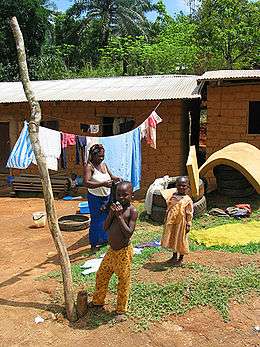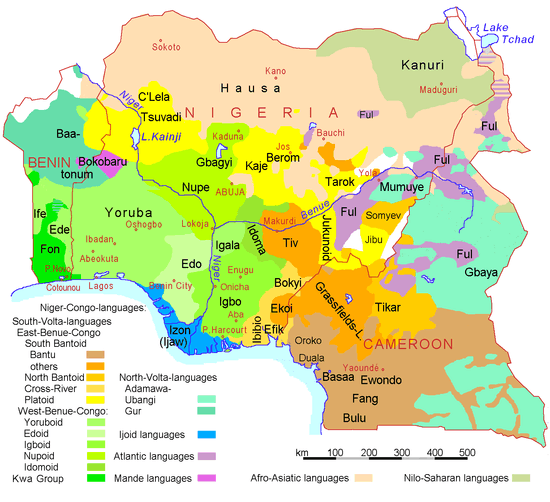Demographics of Cameroon

The demographic profile of Cameroon is complex for a country of its population. Cameroon comprises an estimated 250 distinct ethnic groups, which may be formed into five large regional-cultural divisions:
- western highlanders (Semi-Bantu or grassfielders), including the Bamileke, Bamum (or Bamoun), and many smaller Tikar groups in the Northwest (est. 38% of total population);
- coastal tropical forest peoples, including the Bassa, Duala (or Douala), and many smaller groups in the Southwest (12%);
- southern tropical forest peoples, including the Beti-Pahuin, Bulu (a subgroup of Beti-Pahuin), Fang (subgroup of Beti-Pahuin), Maka, Njem, and Baka pygmies (18%);
- predominantly Islamic peoples of the northern semi-arid regions (the Sahel) and central highlands, including the Fulani (French: Peul or Peuhl; Fula: Fulɓe) (14%); and
- the "Kirdi", non-Islamic or recently Islamic peoples of the northern desert and central highlands (18%).
The Cameroon government held two national censuses during the country's first 44 years as an independent country, in 1976 and again in 1987. Results from the second head count were never published. A third census, expected to take years to produce results, began on November 11, 2005, with a three-week interviewing phase. It is one of a series of projects and reforms required by the International Monetary Fund as prerequisites for foreign debt relief. The first results were published in 2010.[1]
Population
According to the 2010 revision of the World Population Prospects the total population was 19 599 000 in 2010, compared to only 4 466 000 in 1950. The proportion of children below the age of 15 in 2010 was 40.6%, 55.9% was between 15 and 65 years of age, while 3.5% was 65 years or older .[2]
| Total population (x 1000) | Population aged 0–14 (%) | Population aged 15–64 (%) | Population aged 65+ (%) | |
|---|---|---|---|---|
| 1950 | 4 466 | 39.6 | 56.9 | 68.4 |
| 1955 | 4 901 | 40.1 | 56.4 | 3.5 |
| 1960 | 5 409 | 40.6 | 55.9 | 3.6 |
| 1965 | 6 049 | 41.5 | 54.9 | 3.6 |
| 1970 | 6 842 | 42.4 | 54.0 | 3.6 |
| 1975 | 7 838 | 43.6 | 52.7 | 3.7 |
| 1980 | 9 110 | 44.6 | 51.8 | 3.6 |
| 1985 | 10 519 | 45.2 | 51.2 | 3.6 |
| 1990 | 12 181 | 45.2 | 51.3 | 3.6 |
| 1995 | 13 940 | 44.4 | 52.1 | 3.5 |
| 2000 | 15 678 | 42.8 | 53.7 | 3.5 |
| 2005 | 17 554 | 41.6 | 54.9 | 3.5 |
| 2010 | 19 599 | 40.6 | 55.9 | 3.5 |
Vital statistics
Registration of vital events is in Cameroon not complete. The Population Departement of the United Nations prepared the following estimates. [2]
| Period | Live births per year | Deaths per year | Natural change per year | CBR* | CDR* | NC* | TFR* | IMR* |
|---|---|---|---|---|---|---|---|---|
| 1950-1955 | 203 000 | 117 000 | 86 000 | 43.4 | 24.9 | 18.5 | 5.68 | 169 |
| 1955-1960 | 222 000 | 120 000 | 102 000 | 43.0 | 23.3 | 19.7 | 5.68 | 158 |
| 1960-1965 | 252 000 | 124 000 | 128 000 | 44.0 | 21.6 | 22.3 | 5.90 | 145 |
| 1965-1970 | 287 000 | 130 000 | 157 000 | 44.6 | 20.1 | 24.5 | 6.10 | 133 |
| 1970-1975 | 332 000 | 136 000 | 196 000 | 45.2 | 18.3 | 26.8 | 6.30 | 120 |
| 1975-1980 | 382 000 | 143 000 | 239 000 | 45.1 | 16.5 | 28.6 | 6.40 | 108 |
| 1980-1985 | 439 000 | 143 000 | 296 000 | 44.7 | 15.0 | 29.7 | 6.40 | 98 |
| 1985-1990 | 487 000 | 148 000 | 339 000 | 42.9 | 14.1 | 28.9 | 6.10 | 93 |
| 1990-1995 | 536 000 | 172 000 | 364 000 | 41.0 | 14.0 | 27.0 | 5.70 | 94 |
| 1995-2000 | 563 000 | 204 000 | 359 000 | 38.0 | 14.6 | 23.5 | 5.10 | 96 |
| 2000-2005 | 632 000 | 243 000 | 389 000 | 38.0 | 15.3 | 22.7 | 4.92 | 97 |
| 2005-2010 | 691 000 | 270 000 | 421 000 | 37.2 | 15.0 | 22.2 | 4.67 | 94 |
| * CBR = crude birth rate (per 1000); CDR = crude death rate (per 1000); NC = natural change (per 1000); IMR = infant mortality rate per 1000 births; TFR = total fertility rate (number of children per woman) | ||||||||
Fertility and Births
Total Fertility Rate (TFR) (Wanted Fertility Rate) and Crude Birth Rate (CBR):[3]
| Year | CBR (Total) | TFR (Total) | CBR (Urban) | TFR (Urban) | CBR (Rural) | TFR (Rural) |
|---|---|---|---|---|---|---|
| 1991 | 39 | 5,82 (5,17) | 5,17 (4,52) | 6,29 (5,66) | ||
| 1998 | 37,4 | 5,2 (4,6) | 31,5 | 3,9 (3,4) | 40,1 | 5,8 (5,3) |
| 2004 | 37,8 | 5,0 (4,5) | 34,9 | 4,0 (3,7) | 40,5 | 6,1 (5,6) |
| 2011 | 38,1 | 5,1 (4,1) | 34,6 | 4,0 (3,2) | 41,3 | 6,4 (5,1) |
Ethnic groups


- Cameroon Highlanders 31% [4]
- Equatorial Bantu 19%[4]
- Kirdi 11%[4]
- Fulani 10%[4]
- Northwestern Bantu 8%[4]
- Eastern Nigritic 7%[4]
- Other African 13%[4]
- Non-African less than 1%[4]
Languages

There are 24 major African language groups in Cameroon; additionally, English and French are official languages. Cameroonian Pidgin English is also widely spoken.
Peoples concentrated in the Southwest and Northwest Provinces — around Buea and Bamenda — use standard English and Cameroonian Pidgin English, as well as their local languages. In the three northern provinces — Adamawa, North, and Far North — either French or Fulfulde (the language of the Fulani) is widely spoken. Elsewhere, French is the principal second language, although pidgin and some local languages such as Ewondo, the dialect of a Beti clan from the Yaoundé area, have a wide currency.
Indigenous languages of Cameroon include:
CIA World Factbook demographic statistics

The following demographic statistics are from the CIA World Factbook, unless otherwise indicated.
Population
- 19,294,149(2010 est.)
- Note: estimates for this country explicitly take into account the effects of excess mortality due to AIDS; this can result in lower life expectancy, higher infant mortality and death rates, lower population and growth rates, and changes in the distribution of population by age and sex than would otherwise be expected (July 2009 est.)
Median age
- total: 19.3 years
- male: 19.2 years
- female: 19.4 years (2010 est.)
Population growth rate
- 3.129% (2013 est.)
Urbanization
- Urban population: 58% of total population (2010)
- Rate of urbanization: 3.3% annual rate of change (2010–15 est.)
Sex ratio
- At birth: 1.03 male(s)/female
- Under 15 years: 1.02 male(s)/female
- 15-64 years: 1.01 male(s)/female
- 65 years and over: 0.85 male(s)/female
- Total population: 1.01 male(s)/female (2009 est.)
Life expectancy at birth
- total population: 54.04 years
- male: 53.21 years
- female: 54.9 years (2010 est.)
Total Fertility Rate
According to Cameroon government website, average children per woman was 5.0 in 2004.[5]
HIV/AIDS
- Adult prevalence rate: 5.1% (2007 est.)
- People living with HIV/AIDS: 540,000 (2007 est.)
- Deaths: 39,000 (2007 est.)
People living with HIV/AIDS: 370,000 (2010 est.)
Major infectious diseases
- Degree of risk: very high
- Food or waterborne diseases: bacterial and protozoal diarrhea, hepatitis A and hepatitis E, and typhoid fever
- Vectorborne diseases: malaria and yellow fever
- Water contact disease: schistosomiasis
- Respiratory disease: meningococcal meningitis
- Animal contact disease: rabies (2009)
Nationality
- Noun: Cameroonian(s)
- Adjective: Cameroonian
Religions
- Roman Catholic [4] 38.4%, Protestant [4] 26.3%, other Christian [4] 4.5%, Islam [4] 20.9%, Animist [4] 5.6%, Other [4] 1%, Non-believer [4] 3.2% (2005 est.)
Literacy
- Definition: age 15 and over can read and write
- Total population: 67.9% (2004 est.; source: UNDP 2006; NB- this figure is given without reference to which languages are considered)
- Male: 77.0%
- Female: 59.45
Education expenditure
- 3.3% of GDP (2006)
References
| Wikimedia Commons has media related to Demographics of Cameroon. |
- ↑ Cameroon - Third General Census of Population and Housing 2005 - IPUMS Subset (download first findings "Rapport de presentation des résultats définitifs" - pdf)
- 1 2 Population Division of the Department of Economic and Social Affairs of the United Nations Secretariat, World Population Prospects: The 2010 Revision
- ↑ http://microdata.worldbank.org/index.php/catalog/dhs#_r=&collection=&country=&dtype=&from=1890&page=3&ps=&sk=&sort_by=nation&sort_order=&to=2014&topic=&view=s&vk=
- 1 2 3 4 5 6 7 8 9 10 11 12 13 14 15 "Africa ::CAMEROON". CIA The World Factbook.
- ↑ http://www.statistics-cameroon.org/downloads/La_population_du_Cameroun_2010.pdf
 This article incorporates public domain material from the CIA World Factbook document "2008 edition".
This article incorporates public domain material from the CIA World Factbook document "2008 edition".- Cameroon Undertakes Nationwide Census, a November 2005 article from Voice of America
- UNDP. 2006. Beyond scarcity: Power, poverty and the global water crisis. Human Development Report 2006. New York: United Nations Development Programme (UNDP). (Cameroon http://hdr.undp.org/hdr2006/statistics/countries/data_sheets/cty_ds_CMR.html )
